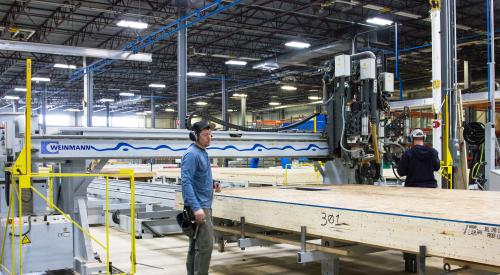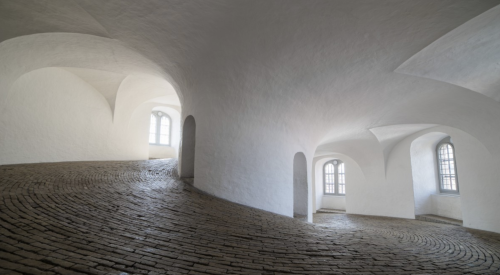|
|
Big bathrooms and kitchens may catch a homebuyer's eye, but innovations behind the walls could be the next hot trend for selling homes. A new approach to integrating plumbing systems can simplify installation, ease maintenance and improve the home's livability, as well as the builder's bottom line.
|
A home run plumbing system runs flexible piping directly to each fixture from the central manifold.
|
|
Home run plumbing with PEX tubing can be installed more quickly and is easily disentangled from the structure and other utilities.
|
|
The Concept Home envisions utilities that are easily accessible and located in vertical chases, baseboards and interstitial spaces.
|
The PATH Concept Home illustrates methods for "disentangling systems" to accommodate both stability and change in homeowners' lives. This approach towards designing and constructing single-family homes has roots in a commercial concept known as "open building." The fundamental idea of "disentangling" is that the primary systems within the home - the structure, the various utilities, and the floor plan - are viewed as separate systems. The structure is built for long-term durability, while the utilities and interior walls are configured to facilitate future changes.
After all, families grow and change, equipment wears out and technologies evolve. Why not build a home to accommodate the inevitable?
Building for the Future
For many homeowners, the prospect of a basic plumbing repair or upgrade means punching holes in finished walls or ceilings - a messy and costly effort. The open building approach treats the utilities - plumbing; heating, ventilating and air conditioning (HVAC); electrical; and communications - as separate entities that are designed and installed in a non-interfering, or disentangled, fashion. For the builder, separating the utilities from each other, as well as from the building structure and from the interior walls, speeds and simplifies construction because the trades don't hinder each other. For the homeowner, maintenance, repairs and remodeling become easier because utilities can be accessed without opening walls, and walls can be moved without relocating utilities.
The underlying design principle for plumbing, electrical, and HVAC systems is to create open pathways for the piping, wiring and conduit runs. The PATH Concept Home model envisions mechanical systems that are disentangled from one another, that can be pre-built in a factory and installed as a package, and that can be accessed through removable panels in ceilings, walls and floors. These removable panels can be built-in baseboards, or attractive wall and ceiling panels (see "How does it play in Peoria?"). The concept can be applied in a wide range of building environments, although it would be less cost-efficient in a slab-on-grade home. There, plumbing runs to first-floor fixtures would have to come from the horizontal runs in the first-floor ceiling.
From Concept to Reality
Tedd Benson, president of Bensonwood Homes of Walpole, N.H., has embraced this idea through his Open-Built system. Noting that homeowner investments in remodeling and repairs equal or exceed the value of new construction, Benson says, "We should be making buildings to accommodate, rather than complicate, this natural requirement."
Bensonwood drawings show piping runs based on intelligent use of space. Open-web floor joists allow plumbing to be run unobstructed below the first floor. Benson supports the second-story flooring off the main structure with metal standoffs, a design tactic that opens up space for clear piping runs below the second floor. These clear piping runs reduce the usual sawing and notching that plumbers have to do. Removable ceiling panels allow plumbers access to these open pathways. This builds flexibility into the construction schedule because plumbers don't have to run the plumbing before the ceiling is installed.
Vertical runs, usually located inside interior walls, are less accessible than horizontal runs. But since most plumbing alterations and repairs affect the horizontal runs, accessibility doesn't often pose a problem. Still, with remodeling in mind, Benson prefers that risers run alongside stairwells because these areas are less likely to be altered except during the most radical remodeling.
Benson also finds a "home run" plumbing system, usually located near the domestic hot water heater, to be highly compatible with the practice of disentangled systems. Home run plumbing consists of a central plastic plumbing manifold that connects the hot and cold domestic water supply to each fixture via flexible cross-linked polyethylene (PEX) tubing.
Plumber Acceptance
Benson of Bensenwood Homes acts as his own general contractor for local work, and he has not had any problem getting his local plumbing subcontractor, Harrington Plumbing and Heating of Westminster, Vt., on board with his Open-Built system. Scott Harrington was quick to see the benefits, both in construction efficiency and in post-construction flexibility.
Harrington notes that Benson's plan was easy to accommodate. The open system reduces the amount of cutting and chopping away at the structure that plumbers usually have to do. It saves him time and money, usually reducing the overall plumbing costs by 10 to 20 percent.
"This is the wave of the future," says Harrington, who has incorporated open-system approach into other jobs and educated builders in the process. For Harrington, the benefits of plumbing open systems have translated into competitive edge over other plumbers.
Benson now considers Harrington a collaborator. They are currently working together to develop a pre-installed plumbing system in which hangers and pipes are pre-manufactured off-site - consistent with the philosophy of disentangled systems - and then quickly installed.
Reaching its Potential
Stephen Kendall, director of the Building Futures Institute at Ball State University in Muncie, Ind., notes that the decades-old open-system concept is finally getting a foothold in U.S. single-family homes through builders like Benson. But one of the biggest obstacles to perfecting open building is the lack of standardization of plumbing fixtures - and HVAC, electrical and controls. Often, one manufacturer's fixture cannot be replaced with an equivalent fixture from another without significant re-plumbing. According to Kendall, techniques like universal connections and heights as well as a defined grid system will enable builders to convert to disentangled systems more easily.
And when might the plumbing and component industries adopt such open building techniques? "If the industry sees the demand, they'll put the research into it and make it happen quickly," notes Dave Viola, technical director of the Plumbing Manufacturers Institute. He points to the volume of research and development in low-flow fixtures over the last four years aimed at exceeding federal standards.
While the industry is busy catching up, pioneering builders like Benson use open building as their signature - and their buyers enjoy the many advantages.
Joyce Mersereau of Concord, Mass., learned more quickly than most new homebuyers the benefits of open building design principles.
"Stuff happens," she can say now, recalling the flood of two years ago, just after she moved into her new Bensonwood home. But when the bolt gave way on the bathtub pipe and water gushed onto the kitchen island below, it was a different scene.
"We freaked out," she recalls. "We were supposed to have an open house in the next couple of days.
"The plumbers came out, popped two ceiling panels out, replaced the bolt, and there we go," she continues. "No hole in the wall, no replastering, no repainting.
"I'm looking up at the panel system now, as we talk, and I think it's more beautiful than plaster, too."








